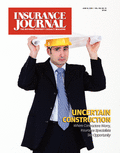The issue of state versus federal regulation of insurance provokes strong opinions and divergent points of view among insurers. Yet there is one point on which we all can agree—consumers are best served by a healthy and competitive insurance marketplace. The National Association of Independent Insurers (NAII) believes that state regulation of insurance is the most desirable means to achieve such an environment.
This is the clear and consistent message NAII and others are sending to Congress during the series of hearings being held by the House Financial Services Subcommittee on Capital Markets, Insurance and Government Sponsored Enterprises on the effectiveness of state regulation.
Earlier this spring, Rep. Richard Baker (R-La.), chaired a hearing that examined how various regulatory structures impact insurance availability. Federal lawmakers heard testimony on market conditions in South Carolina, New Jersey, Louisiana and Illinois.
We applaud Chairman Baker’s effort to determine which regulatory structure delivers the most value to consumers. And we are confident that after hearing all the testimony he will come to the conclusion that state regulation is the best way to foster a marketplace in which competition flourishes.
As we have seen in Louisiana, New Jersey and Texas—three of the most highly regulated states—great opportunities often arise out of crisis. Legislators in these states came forward with reforms that are designed to serve as a catalyst for renewed competition in the marketplace.
These reforms have important implications for the future of insurance regulation as a whole. With Congress eyeing state regulation of insurance, it’s critical to show progress in improving it, especially in tough states where previous regulatory reform efforts have failed. Success in these states bodes well for the entire regulatory system.
By adopting competition-based regulatory systems, legislators improve the marketplace for consumers and the industry. The victories for regulatory modernization provide proponents of state regulation, such as NAII, with concrete examples of how states are improving, and reduce the need or incentive for additional federal intervention.
This year in Texas, lawmakers scrapped the antiquated benchmark rating system and replaced it with a prior approval system for rates that will become a file-and-use system in 2005. While the new law gives significant authority to the insurance commissioner and much depends on how the law is implemented, there is a real opportunity to rejuvenate the Texas market by allowing companies to compete on price, product quality, and customer service.
Louisiana legislators avoided a full-blown homeowners insurance crisis by enacting laws to establish a limited flex-rating system and re-vamp the way the state’s residual market plans are funded. These changes are likely to prompt insurers who abandoned the state in recent years to take a serious look at re-entering the market, and allow those companies still doing business in Louisiana to write more policies.
In New Hampshire, the Legislature has sent to the governor the NAII-backed NCOIL model legislation for a use-and-file approach to regulation of personal lines rates. The legislation also provides further modernization for commercial lines by lowering the exempt commercial policyholder threshold to $100,000 and making most other commercial lines use-and-file.
NAII continues to push for regulatory improvements in other states, including New York, Rhode Island and South Carolina. It’s also important to note that NAII is working towards reforms in the regulatory arena, prodding insurance departments to adopt operational efficiencies that will speed up rate and form approvals.
Unfortunately, we have also seen states such as Nevada and Washington miss their opportunity to improve by adopting flex-rating proposals. On the bright side, these near-successes have generated real momentum for future efforts in these states.
Competitive insurance markets keep rates down, spur innovation among companies, prevent price gouging and allow the regulator to focus on monitoring market conditions, insurance company practices and insurer solvency. The plan is grounded in the principle that competition and free market forces provide the most efficient, varied and cost effective flow of services to the public.
Eliminating some of the disparities among the states with regard to the competitiveness of markets is a key part of improving the whole regulatory system. No matter how one views the possibility of federal intervention in the regulation of the insurance business, getting regulatory reform enacted in the states—especially in tough states like New Jersey, Texas and Louisiana—can only be viewed as a positive development.
Robert Zeman is senior vice president, state government affairs for the National Association of Independent Insurers (NAII). Its 715+ member companies write more than $101 billion in annual premium, more than 32 percent of the nation’s property/casualty insurance.
Topics Texas Legislation Louisiana New Jersey
Was this article valuable?
Here are more articles you may enjoy.


 US E&S Growth Slowed Again in ’24; Berkshire, AIG Top Premium Rankings
US E&S Growth Slowed Again in ’24; Berkshire, AIG Top Premium Rankings  Insurance Sector Should Be on the Lookout for ‘Scattered Spider’ Hackers
Insurance Sector Should Be on the Lookout for ‘Scattered Spider’ Hackers  Weeks Later, Erie and Philadelphia Insurance Still Working to Restore Networks
Weeks Later, Erie and Philadelphia Insurance Still Working to Restore Networks  Soaring Temperatures Stress US Grids
Soaring Temperatures Stress US Grids 


